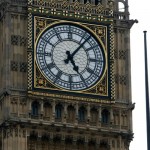 Sunday morning here in Israel, at 2 a.m., Daylight Saving Time ended and the clock was moved back one hour.
Sunday morning here in Israel, at 2 a.m., Daylight Saving Time ended and the clock was moved back one hour.
Daylight Saving Time will resume on March 25, 2016.
History of DST in Israel – Pre-1992
Before 1992, DST was governed by the Time Act, a law inherited by Israel from the British Mandate of Palestine. Summer Time was introduced in Israel between the years 1948-1957, but the length of Daylight Saving Time has changed significantly depending on the year. In 1951-1952, it was enacted for about seven months, whereas in the years 1953-1954 it was enacted for only three months. In 1958, daylight saving time was canceled. Due to the global energy crisis because of the aftermath of the Yom Kippur War, Summer Time was enacted again from 1974-1975.
Up until 1992, Daylight Saving Time was operated by an order of the minister of the interior. In 1980 the authority of the minister for this matter was contested in an appeal to the Supreme Court. The Supreme Court decided that the minister’s authority was indeed more limited than the common practice, as he may only decide on the dates of Daylight Saving Time while its operation is unquestionable. Following this decision the Knesset amended the Time Act so the minister will also have the authority to abolish DST in a certain year.
1992 – 2005
The Chok Kvias Hazeman, or Law Determining the Time, is an Israeli law governing Israeli Daylight Saving Time. It was approved by the Knesset in 1992, replacing the British Mandate of Palestine time act inherited by Israel. The 1992 time zone law cancelled the Time Act, and stipulated that Daylight Saving Time will be operated for at least 150 days each year, and that the final dates will be decided by the minister of the Interior, subject to the approval of the Knesset committee for internal affairs.
Post 2005
Until 2005, the start and end of Daylight Saving Time each year was established in an ad hoc fashion as the result of haggling between political parties representing various sectors of Israeli society. Parties representing religious groups wanted the start delayed till afterPesach and the end to precede Yom Kippur, while the secular parties would argue for starting it earlier and ending it later. Thus, there was no established rule that could guarantee a predictable changeover in either direction.
The debates about a fixed rule for determining the dates of Daylight Saving Time went on for years, and resulted in a suggestion that Daylight Saving Time will start on the 2nd day ofPesach and end on the weekend between Rosh Hashanah and Yom Kippur. This suggestion was rejected as it stipulated an annual Daylight Saving Time period of only 5 months, and yet it served as the basis of the final compromise. After 2005, the annual debate has been effectively ended.
Interestingly, in the past, the unpredictability of DST in Israel became frustrating enough that Microsoft Windows stopped trying to track changes and just made Israeli time be Greenwich Mean Time plus two hours (GMT+2) (and disabled the Daylight Saving Time option). This has led to various ad hoc solutions to the problem in Windows systems and other Microsoft software (e.g. Outlook calendar entries are often off by an hour when shared, due to the lack of DST support).
{Matzav.com Israel News Bureau}












At least if you show a picture of the clock at the UK Houses of Parliament, you could mention that the clocks went back 1 hour in the UK as well, following the well-known adage “Autumn back, Spring forward”.
PS the picture does not show Big Ben, as that is the name of one of the bells in the clock tower, and not the name of the clock – see https://en.wikipedia.org/wiki/Big_Ben.